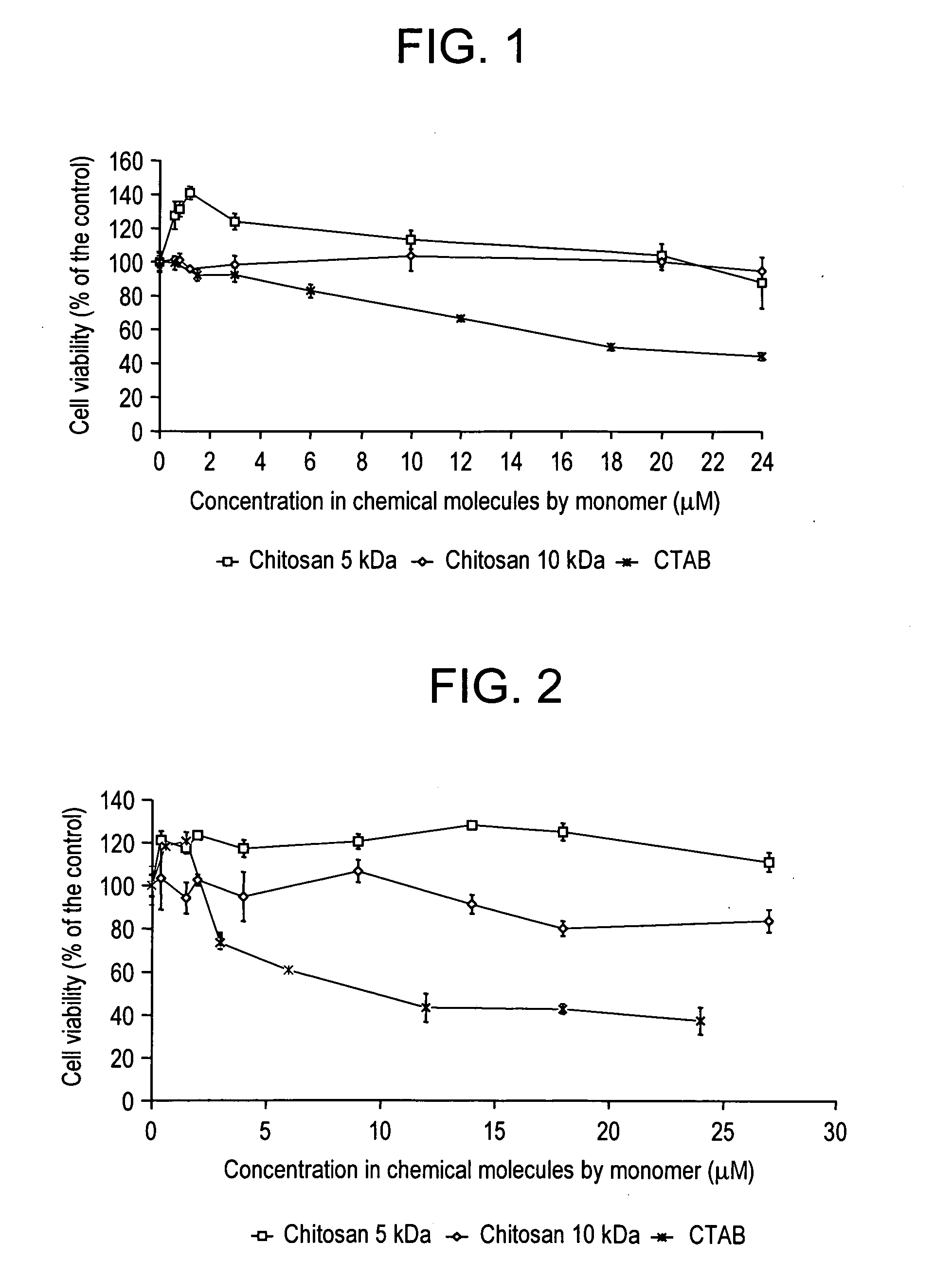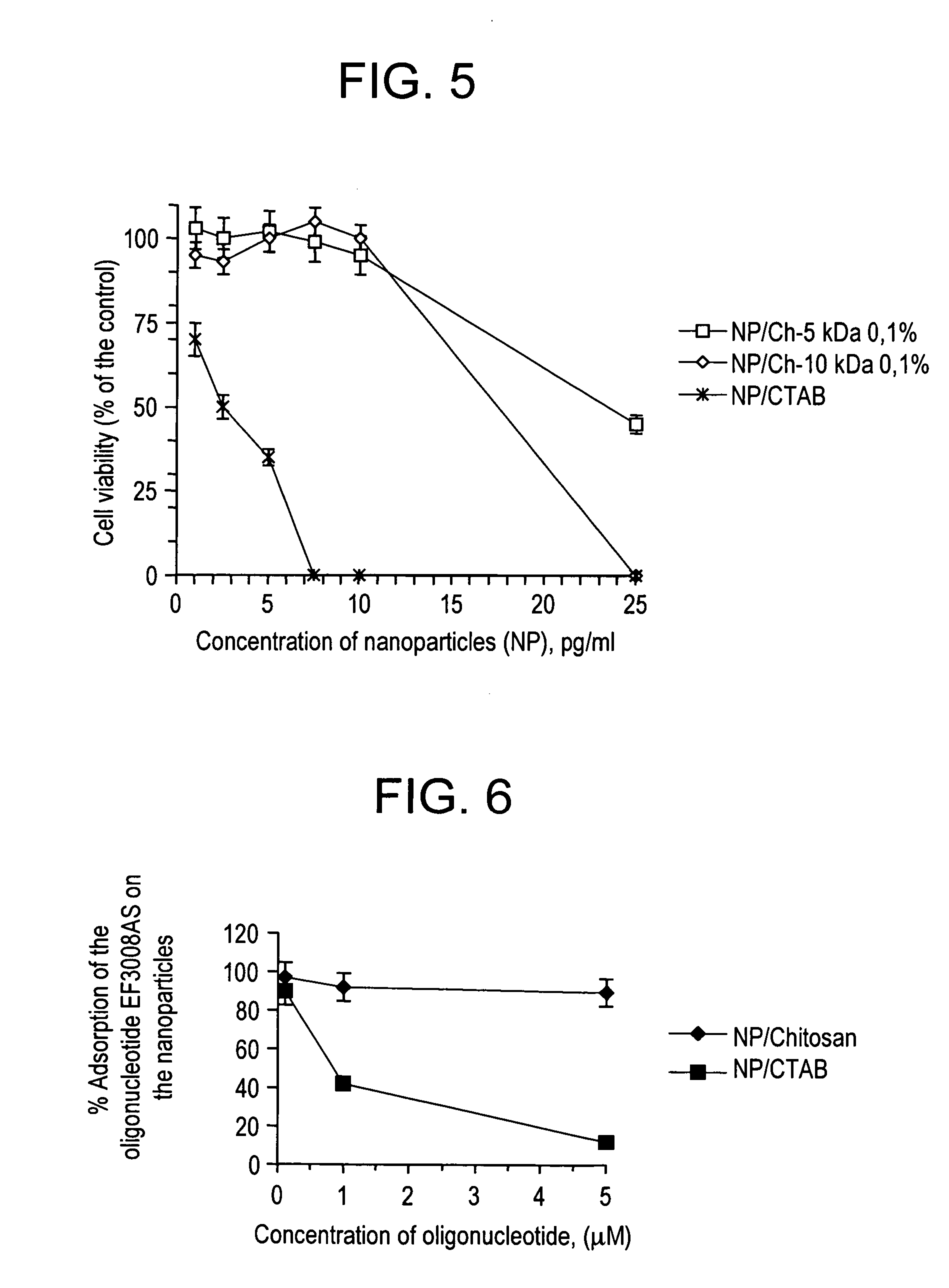Vectorization system comprising nanoparticles of homogenous size of at least one polymer and at least one positively charged polysaccharide and method for the preparation thereof
- Summary
- Abstract
- Description
- Claims
- Application Information
AI Technical Summary
Benefits of technology
Problems solved by technology
Method used
Image
Examples
example i
Comparison of Toxicity of Chitosan of Different Molecular Weights and CTAB on Different Cell Lines
1. Materials and Methods
[0062] The NIH 3T3 and NIH 3T3 EWS-Fli-1 (adherent cells) were sown on 6-well plates at 100,000 cells per well in their culture medium without puromycin and the IW35 cells (cells in suspension) in 12-well plates at the rate of 750,000 cells per well. Other cells in suspension CEM 4FX were also tested. They were sown at 10,000 cells per well in 96-well plates.
[0063] For the first two cell types, the cells were sown 24 hours prior to their transfection. The medium was then eliminated and 100 μl of solution of the complex to be tested was brought into contact with the cells in 900 μl of medium.
[0064] Different concentrations of CTAB and chitosan of various molecular weight were tested.
[0065] Two controls were used and corresponded to the cells in the culture medium on the one hand and in the culture medium containing 100 μl of NaCl 150 mM on the other hand. Af...
example ii
Formulation of Positively Charged Nanoparticles in the Presence of Chitosan of Different Molecular Weights
[0068] The nanoparticles were prepared by the emulsion polymerization technique (Couvreur et al., 1979). 100 ml of polyisohexylcyanoacrylate containing SO2 (Monorex®) was added to a solution of citric acid diluted to pH=3 containing 1% of nonionic surface-active agent, poloxamer 188, containing or not containing 0.5% cyclodextrin and containing 0.2% chitosan of low molecular weight (5,000 or 10,000 Da). The duration of polymerization was 6 hours. After polymerization, the size was determined after dilution of the particles in MilliQ water and the zeta potential was determined after dilution of the particles in NaCl 1 mM. Table 1 below presents the size and the zeta potential of the nanoparticles in relation to the molecular weight of the chitosan.
TABLE 1DiameterStandardPolydispersityZeta(nm)deviationindexpotentialChitosan MW58160.025+215 kDananoparticlesChitosan MW60150.065+2...
example iii
Comparison of Toxicity of Nanoparticles Charged with Chitosan and with CTAB
1. Materials and Methods
[0071] CEM 4FX cells in suspension were sown at the rate of 10,000 cells per well in 96-well plates. Different concentrations of nanoparticles possessing positive charges from addition of CTAB or chitosan 5 kDa and 10 kDa were tested.
[0072] Two controls were used and corresponded to the cells in the culture medium on the one hand and in the culture medium containing 100 μl of NaCl 150 mM on the other hand. After 24 hours of incubation, the measurements of cytotoxicity were performed by a test measuring the activity of the mitochondrial dehydrogenase enzymes of the living cells by oxidation of MTT in formazan. The amount of formazan produced is directly proportional to the number of metabolically active living cells. The cells were washed with PBS and 1 ml of the medium was added. The cells were then incubated at 37° C. with 100 82 l of a solution of MTT (5 mg / ml in PBS) for 3 hours...
PUM
| Property | Measurement | Unit |
|---|---|---|
| Fraction | aaaaa | aaaaa |
| Mass | aaaaa | aaaaa |
| Mass | aaaaa | aaaaa |
Abstract
Description
Claims
Application Information
 Login to View More
Login to View More - R&D
- Intellectual Property
- Life Sciences
- Materials
- Tech Scout
- Unparalleled Data Quality
- Higher Quality Content
- 60% Fewer Hallucinations
Browse by: Latest US Patents, China's latest patents, Technical Efficacy Thesaurus, Application Domain, Technology Topic, Popular Technical Reports.
© 2025 PatSnap. All rights reserved.Legal|Privacy policy|Modern Slavery Act Transparency Statement|Sitemap|About US| Contact US: help@patsnap.com



